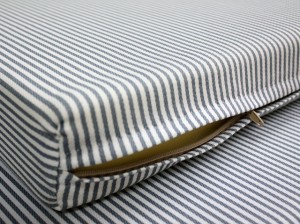In our fifth and final installment of our series on best practices for maximizing the life of your mattress, we offer Tip #5, which includes the real reason some mattresses have those flimsy handles and why you should always lift with your knees and not… a rope?
Previous posts:
Extending the Life of Your Mattress: Part I – Keeping Your Mattress Dry
Extending the Life of Your Mattress: Part II – Keeping Your Mattress Covered
Extending the Life of Your Mattress: Part III – Using Your Mattress Like a Mattress
Extending the Life of Your Mattress: Part IV – Supporting Your Mattress
—
Tip #5: Be Gentle With Your Mattress
 Sometimes it’s hard to wrap your mind around the idea of a mattress, with its size and ability to hold hundreds of pounds, as being something relatively delicate. And while mattresses don’t necessarily need to be treated like your finest china, not handling it roughly will help boost its longevity. This is another tip that seems obvious, but given the situations people find themselves in, combined with what they consider at the time to be practical ingenuity, the things done to mattresses to move or get them where they need to be can be extreme. It is best to resist these urges to take the easiest route when manipulating your mattress, because even though “work smarter, not harder” applies to most situations, with mattresses, “a little hard work goes a long way,” can be a much more applicable statement.
Sometimes it’s hard to wrap your mind around the idea of a mattress, with its size and ability to hold hundreds of pounds, as being something relatively delicate. And while mattresses don’t necessarily need to be treated like your finest china, not handling it roughly will help boost its longevity. This is another tip that seems obvious, but given the situations people find themselves in, combined with what they consider at the time to be practical ingenuity, the things done to mattresses to move or get them where they need to be can be extreme. It is best to resist these urges to take the easiest route when manipulating your mattress, because even though “work smarter, not harder” applies to most situations, with mattresses, “a little hard work goes a long way,” can be a much more applicable statement.
Many times when individuals buy new mattresses, the company they are purchasing from will deliver the mattress to the home with a couple of movers who carry it to its location within the home. That is a great service, not only because it’s easy but also because multiple people equally carrying a mattress is the best way to move it. Because of this, the arrival of a mattress is usually not when you need to be concerned with the handling. Foam or air mattresses that arrive in much smaller packaging than their ultimate size are also easy to move to the bedroom. But when it’s time to handle the mattress on your own, be it because of remodeling, cleaning, moving, or flipping the mattress, that’s when damage often occurs.
One of the easiest mistakes to make with traditional innerspring mattresses is in the use of the handles many come with. Contrary to the way they are often used, handles on a mattress are not for carrying a mattress. They are actually intended for the positioning of a mattress on its foundation, so before you complain to a manufacturer about flimsy handles tearing off, know that unless you were only adjusting your mattress, you weren’t using them for their intended purpose. And just to be clear, this also includes the process of circumventing stairs in apartments or second story bedrooms by attaching straps and ropes to the handles of a mattress to hoist it up through a balcony or window. Unless you have a forklift to gently lift it to the floor where you want it, you should probably stick to the old-fashioned way of getting your mattress where it needs to go.
Other bedding materials offer a little more flexibility in terms of their transport. Foam mattresses, while weighing about the same amount as innerspring mattresses due to the material consistency throughout the entire product, can withstand certain types of handling better than other types. An innerspring mattress for example, should generally not be folded to get it through a doorway at risk of breaking or damaging the springs. Foam on the other hand, can be manipulated in many ways, as long as caution is taken to not tear the product due to too much force. Most foam mattresses are vacuum sealed for delivery, attesting to their resilience. They can be folded, rolled and compressed if they need to be moved, provided thin straps that can cut into the material aren’t used. Grabbing corners and edges by the handful can cause tearing as well, given the weight of the full product. Air mattresses are obviously the easiest to transport since they can be deflated, but when opening or packaging them be sure not to puncture the shell, with the same going for foam and waterbeds. An additional tip when moving a mattress is to never hold on to the tag when carrying it. If a tag is removed from a mattress and then lost, many manufacturers will not honor the product warranty.
So that concludes our series of suggestions for getting the most life out of your mattress. Hopefully you found our suggestions easy to follow, helping you maintain a comfortable bed for years to come!

